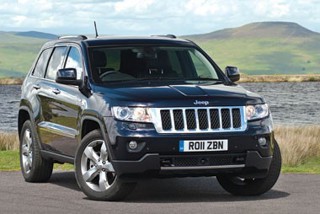Review
By Tom Seymour
The Jeep Cherokee is phase two of the brand’s recovery plan after parent company Fiat Chrysler Automobiles (FCA) came very close to dropping the franchise in the UK in 2012.
Jeep will become the lead franchise for Chrysler Jeep dealers with the new Cherokee leading volumes until the Fiat 500L-derived Renegade arrives next year.
Steve Zanlunghi, Fiat Group Automobiles UK chief executive and managing director, told AM the Cherokee would add 2,000 units to Jeep volumes in its first six months, building up to approximately 4,000 units in a full year.
Jeep ended 2013 with registrations of 2,229 units so it’s clear what kind of an impact Zanlunghi is expecting the Cherokee to have. Jeep has already posted 1,276 units in the first five months of the year and increased market share from 0.10% to 0.12% YTD.
Jeep has a strong badge to trade on and the business is expecting to pull in conquest sales on the back of improved build quality and styling that is more to European tastes.
It’s a difficult line to walk for Jeep. In order for sales to take off in Europe, it needs to abandon some of its American heritage, but that quintessential Americana is also what gives the badge its strength.
There are little nods to Jeep’s past, with a WWII Jeep silhouette on the interior of the windscreen, but this is very much being marketed as an on-road vehicle, rather than a mud-plugger.
The interior quality in the cabin has been improved massively over previous generations. Zanlunghi told AM that under DaimlerChrysler ownership, Chrysler engineers were told to strip out cost from the interior on previous Jeeps to stop it competing with internal products.
Under Fiat’s ownership, fit and finish has been improved on the Cherokee (which is based on the Alfa Romeo Giulietta platform). The dials on the dash are more tactile and any areas the driver touches are soft-touch plastic.
There’s still a little bit of hard plastic to be found, but it’s a big improvement. One concerning area, however, was the fitment of the centre console in the back of the Cherokee, which was quite loose on the two test cars AM tried on the UK launch.
The Cherokee has extremely comfortable and squashy seats. There’s not much lumbar support, but the seats take some of the harshness out of the new Jeep’s ride.
Initially, the new Cherokee will be available with a choice of 140bhp and 170bhp 2.0-litre turbo-diesel engines. The top-selling higher powered diesel is capable of 48.7mpg and has CO2 emissions of 154g/km. Customers can choose from four trim levels: Longitude, Longitude+, Limited and Trailhawk.
The Trailhawk trim will only be available by special order towards the end of this year and will be powered by a 3.2-litre petrol engine.
The higher-powered diesel is adequate and the nine-speed auto is smooth enough, but it’s not as refined as the nine-speed available with Land Rover.
The Cherokee actually feels slightly better to drive in manual mode with the lower-powered diesel, there’s more control over the gears and there doesn’t appear to be a huge performance difference on the road despite a 30bhp drop in power.
While the Cherokee starts at £25,495, the majority of sales will be the £35,695 Limited 9-speed automatic model. This price point puts Jeep right up against some tough opposition, such as the BMW X3 and Audi Q5.
Customers could also be looking at a top-of-the-range Kia Sportage and still have more than £6,000 to spare. The arrival of the Land Rover Discovery Sport later this year (the replacement for the Freelander) will likely add another tough competitor to crossover customers’ consideration lists.
Part of Jeep’s marketing strategy will be to invite comparison. Its ‘dare to compare’ campaign will let customers make like-for-like comparisons against competitors and Jeep is particularly keen to push the technology angle.
Each model features a thin-film transistor (TFT) screen in the instrument cluster available in either monochrome or colour.
On the centre console there’s a choice between a five-inch colour touch-screen for the Uconnect media system and, in a first for this class, an 8.4-inch display. The entry-level Longitude model comes with cruise control, parking sensors and dual-zone air-conditioning as standard.
One highlight is an optional wireless smartphone charging pad on the centre console. It’s a neat addition and in this case, Jeep is ahead of the smartphone curve, with only the newest phones being compatible with the device (dealers can include sleeves which will charge any phone, but this somewhat defeats the purpose).
The Cherokee is another positive step for Jeep, following the Grand Cherokee, with improved quality over the previous generation and technology which will help it compete in the sector.
While it’s not strong enough to rival German products on style and quality, it is still a credible option that Jeep is hoping will help it onto customer consideration lists.
What your customers will be reading about the Cherokee
Autocar
The new Jeep Cherokee is an improvement over the old model, but it isn’t yet in the league of German competitors.
Auto Express
At long last, Jeep has come up with a crossover that’s a credible mainstream choice. The new Cherokee trails the class leaders because of its poor handling, lack of reassuring steering weight and relatively high noise levels, but it remains an encouraging first step.
Author:
Tom Seymour
Freelance writer
Factsheet
- Price
- £25,495-£35,695
- Engine
- 2.0-litre 140bhp/170bhp diesel
- Performance
- 0-60mph 10.3-12 secs; 117-119mph top speed
- Transmission
- 6-sp man; 9-sp auto
- Efficiency
- 48.7-53.3mpg; 139-154g/km CO2
- RV 3yr/30k
- 36%
- Key rivals
- Audi Q3, BMW X3, Land Rover Discovery Sport

















